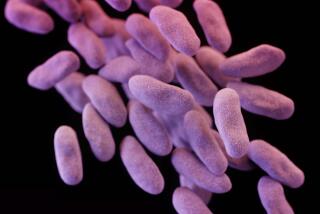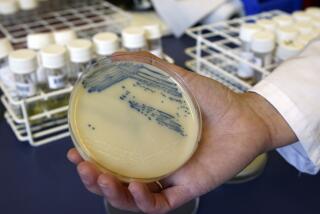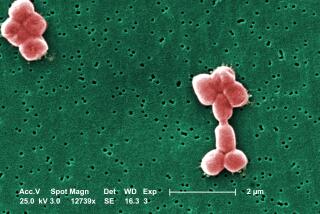New antibiotic teixobactin kills drug-resistant superbugs, study says
Using soil from a grassy field in Maine and a miniaturized diffusion chamber, scientists have cultivated a microbe that could help tame the spread of antibiotic-resistant superbugs.
When tricked into growing in a lab, the microbe makes a compound that kills strains of tuberculosis, MRSA and other deadly pathogens that are immune to even the most powerful drugs. Tests in mice showed that the newfound molecule is “exquisitely active against some very hard-to-deal-with bugs,” said Northeastern University microbiologist Kim Lewis, the senior author of a study published Wednesday in the journal Nature.
Experts said the discovery could lead to a new class of antibiotics for the first time in decades. If so, it would give doctors a much-needed weapon in the microbial arms race that has tilted in favor of bacteria.
The World Health Organization has warned that the rise of antibiotic-resistant bacteria threatens to undermine the advances made by modern medicine. In the United States, more than 2 million people are sickened by such infections each year, and 23,000 of them die as a result.
Most of the workhorse drugs in use today were developed at least 50 years ago. During the heyday of antibiotic research immediately after World War II, soil microbes yielded the mainstays in the fight against deadly infections.
Lewis and his colleagues revived that idea to find a new species of bacteria they named Eleftheria terrae.
Soil is chock full of microbes, but most don’t readily form colonies in petri dishes. In addition, many of the organisms uncovered in such samples are identical or similar to ones already developed.
“You inevitably are rediscovering penicillin and streptomycin,” Lewis said.
To encourage new bacteria to grow, the researchers couldn’t just dump their dirt into a laboratory dish. Instead, they isolated minuscule samples in diffusion chambers that functioned as bacterial incubators. Then they put the samples back in the soil.
“Essentially we’re tricking the bacteria,” Lewis said. “They start growing and form colonies.”
The experiment yielded about 10,000 strains of bacteria, which were laboriously sorted and studied.
Researchers then checked to see whether any of the strains could kill streptococcus bacteria. Finally, they extracted the antibacterial molecule from E. terrae, one of the more promising strep killers.
Trials on mice showed that the molecule, which they called teixobactin, rapidly cleared infections of drug-resistant strains of Mycobacterium tuberculosis and Staphylococcus aureus bacteria, according to the study. They also felled two kinds of bacteria that cause serious infections of heart tissue, Lewis said.
The compound attacks these and other gram-positive bacteria by binding to chemicals essential to forming cell walls, causing them to break down.
“Not only one target is attacked, but multiple targets, and they are all lethal,” said study coauthor Tanja Schneider of the University of Bonn in Germany.
This mechanism of destruction makes it much more difficult for bacteria to develop resistance to teixobactin. Most antibiotics attack proteins, but the DNA that codes for these proteins is known to mutate. Over time, some of these mutations allow bacteria to evade a drug’s lethal effects.
The DNA that includes instructions for making cell walls is far less likely to mutate, researchers said. Indeed, when they tried to encourage bacteria to develop resistance to teixobactin, they couldn’t.
Lewis said teixobactin kills so quickly that target bacteria will have less time in which to develop resistance.
It took about 30 years for bacteria to develop resistance to a similarly acting antibiotic, the study noted. Researchers said any new drug probably would remain effective at least as long.
Converting teixobactin into a safe, effective and marketable drug could take about five years and cost several hundred million dollars, according to the academic-biotech coalition that made the discovery.
“We will probably be in clinical trials two years from now,” Lewis said.
Lewis said the successful cultivation of the proteobacteria that produced the antibiotic suggests that mining soil for new medicines may once again prove fruitful in the search for weapons against human pathogens.
Researchers said they would work to broaden the spectrum of bacteria the molecule can fight, and tinker with its chemistry to ensure it can be administered in reasonable doses.
Although the study represents a “new twist” in the effort to develop new antibiotics, it remains untested in humans, said Dr. Richard Seabrook, head of business development at the London-based Wellcome Trust, which was not involved in the study. “We will not know whether teixobactin will be effective in humans until this research is taken from animal testing in the lab to clinical trials,” he said.
NovoBiotic Pharmaceuticals of Cambridge, Mass., owns the patent for the new molecule. Several of the researchers have financial stakes in the company.
Financial support for the research also came from the U.S. National Institutes of Health and the German government.







